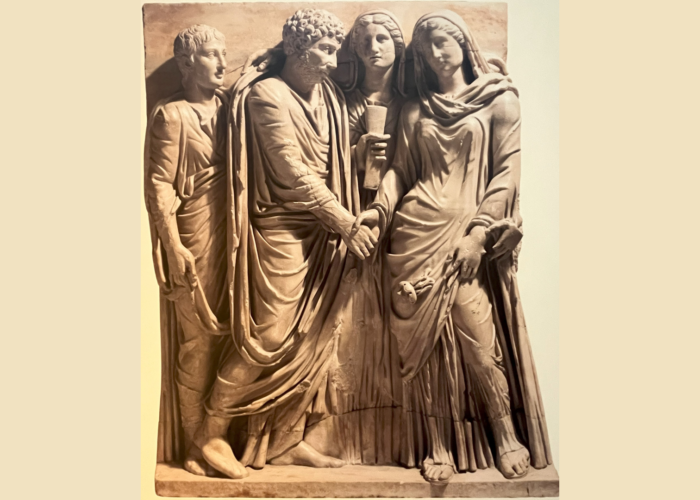With the latest census data indicating that the number of Australians who identity as Christian has plummeted to an all-time low (from 61% in 2011 to 44% in 2021), the church is asking questions of itself and its place in the broader, and increasingly, secular community. This conversation, however, feels somewhat anxious – emerging from a sense of diminished influence and social identity. I wonder if there is a more appropriately Christian reaction. Over the years I have been intrigued by Rodney Stark’s socio-historical work which maps the way in which Christianity surprised itself by becoming the world’s largest religion.
In AD 33, after the first Easter, there were approximately 100 Christians in the entire world. Four centuries later, Augustine of Hippo remarked: “the Church had been expanded, bearing fruit, and growing in the universal world, when in every part thereof, persecution was raging.”[1]
In his 2011 book The Triumph of Christianity (on Amazon here) Rodney Stark proposes a growth rate of 3.4 percent as the most plausible explanation of the exponential growth required to reach the more than 31 million Christians in the Roman Empire by the year AD 340 – an estimated 52.9 percent of the total population![2]

What explains such sustained and remarkable growth? As a social-historical work, Stark identifies the following fascinating reasons for this Christian ‘success’.
Social Inclusiveness
The cities of the Roman Empire were diverse places, made up of various religious groups, races and social classes. The ancient world was status orientated and had embedded within it, ingrained social hierarchies. Into this world the Christian message proclaimed a counter-cultural social reality:
There is neither Jew nor Gentile, neither slave nor free, nor is there male and female, for you are all one in Christ Jesus. – Galatians 3:28
Slaves discovered they were brothers and sisters with their masters “ in the Lord”, and ethnic groups and minorities discovered a belonging that did not require circumcision or other socio-religious markers for adherence. The monotheism of Christianity was theologically and ethically demanding, and yet strangely inclusive, and no doubt attracted many as they observed how Christians loved one another as equals.
Misery and Mercy
The nature of urban cities in the ancient world meant they were crowded and unsanitary places. There was an ever-present risk of disease, and death was never far away. It is likely that a third or more of the population died during two epidemics which swept through the Empire during the second and third centuries. In AD 260 Bishop Dionysius of Alexandria observed the populations fleeing from their dearest but contrasted this with the attitude of those in the Christian communities:
Heedless of danger, they took charge of the sick, attending to their every need and ministering to them in Christ, and with them departed this life serenely happy; for they were infected by others with the disease, drawing on themselves the sickness of their neighbors and cheerfully accepting their pains.
In the ancient world, mercy was regarded as a character defect and pity a pathological emotion. And yet into this moral climate came the ethic of Christianity in which love was a primary virtue. In contrast to the Greco-Roman gods, who were merciless, Jesus’ commandment to love one another was a revolutionary one that applied not only within the Christian community but was to extend to those outside of it. Later in the fourth century we read of the emperor Julian, seeking to restore paganism by exhorting the pagan priesthood to compete with the charity of the Christian church. He urged the distribution of food to the poor, noting that “the impious Galileans [Christians], in addition [to] their own, support ours, [and] it is shameful that our poor should be wanting our aid.”
To return to the issue of the plagues, Stark suggests that the elementary care of the Christians would have had two results. Firstly, their courage and kindness in the face of such risks would have attracted outsiders to their faith. And secondly, because basic care would have increased the chance of recovery, “Christians as a group would have enjoyed a far superior survival rate, and the percentage of Christians in the population would have increased substantially as a result of both plagues.”
Appeals to Women
Although in no ancient group were women equal to men, there were differences in the degree of inequality that women experienced, and women were considerably better off in Christian communities than their other pagan and Jewish counterparts. The most influential theologian and practitioner of the New Testament era was the Apostle Paul who, in Romans 16:1-10, publicly honoured ten women, describing them as co-workers, benefactors and servants of the church. Within Christian marriages Paul described an equality of authority and decision making (1 Cor. 7:2-6) that was quite unimaginable in the prevailing social context. Although the wider structures of society were restrictive, the inner life of the church was to reflect that both men and women were co-heirs together in eternal life (1 Pet 3:7).
The value of woman impacted many areas of ancient life. Christian communities, like Jewish communities, rejected abortion and infanticide and their commitment to sexual activity within their marriage likely resulted in more children, and certainly in more daughters. This ancient love letter from a pagan husband to his pregnant wife reflects the unremarkable way in which the exposure of female infants took place: “If—good luck to you!—you should bear offspring, if it is a male, let it live; if it is female, expose it.”[3]
Moreover, whereas it was generally accepted for pagan husbands to engage in extra-martial sex, Christian sexual ethics resulted in fewer sexually transmitted diseases which in turn increased overall health and reproductive outcomes. More stable Christian marriages, and a relatively higher number of females as a percentage of the Christian community, likely increased the population of Christian women in proportion to the broader population. As well as attracting other women to Christianity, the literary history indicates the significant influence that such Christian women had on their children, pagan husbands, and wider society.
Persecution and Commitment
Up until the beginning of the third century, Christian communities experienced varied levels and modes of persecution. Usually it was social exclusion, but sometimes it was downright cruel. Nero’s persecution in the first century lasted several years and among other things, resulted in Christians being set alight as torches for imperial functions. Rather than denting the growth in Christian conversion, these persecutions seemed to inspire more people to join their movement. Stark notes that “the fundamental problem facing all religions is one of credibility.” When outsiders observed the courage of these suffering Christians, even unto death, such martyrs garnered the respect and curiosity of their fellow pagans.
Make the teaching about God our Saviour attractive
There is much more to say about the growth of the Jesus movement through those first centuries. The Christian community saw themselves as ambassadors of an important, even royal message. Christianity is inherently theological and its truth claims both attracted some and no doubt repelled others. But what Stark rightly points out is that these Christians did not have a recognisable growth strategy – indeed they would have been very surprised at what resulted. Reflecting on all this, Paul Barnett observes that there is a vital lesson from Stark’s work:
…be sure what you believe and give practical expression to it, including out there among people in a society that has forgotten about the faith that gave it its best values. The negative flip side to that is: don’t water down what you believe. A pagan society might be hostile to Christians but it recognises a watered down version of it for what it is, insipid.[4]
To return to our recently released census data, it is worth noting that whereas formal religious identity may be decreasing, many still identify more broadly as spiritual. The results from the 2021 Australian Community Survey found that more than half of Australians believed in God or a higher power (55%), six in ten prayed or meditated, and two in ten attended religious services at least monthly.[5] No doubt Christianity is increasingly unfamiliar to large portions of the population but surely this provides opportunities for Christians to clear away the misconceptions and give expression to their commitments in a beautiful and attractive way (Tit. 2:10). What better example to follow than that of the early Christian community, who really did, quite surprisingly, conquer the world with their kindness.
Therefore, as we have opportunity, let us do good to all people, especially to those who belong to the family of believers. – Galatians 6:10
[1] Augustine, “Expositions on the Book of Psalms,” ed. Philip Schaff and Arthur Cleveland Coxe, D.D., LL.D., trans. Arthur Cleveland Coxe, D.D., LL.D., (1894) in The Complete Works of Saint Augustine (2013), Kindle edition, “Psalm LXXIX [3667].”
[2] Stark, The Triumph of Christianity, 2011, ch. 9, “Assessing Christian Growth”, 138-140. My article follows closely Part II – Christianizing the Empire of Stark’s book.
[3] To ‘expose’ was to practice infanticide, that is, to leave an infant to perish by exposure to the elements.
[4] Barnett, A Future for Christianity? Unpublished paper.
[5] Aussies may be losing their religion but not their need for hope and love – Eternity News



